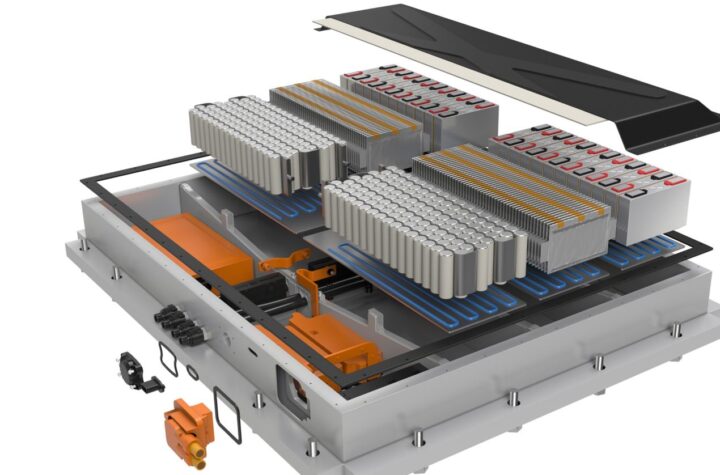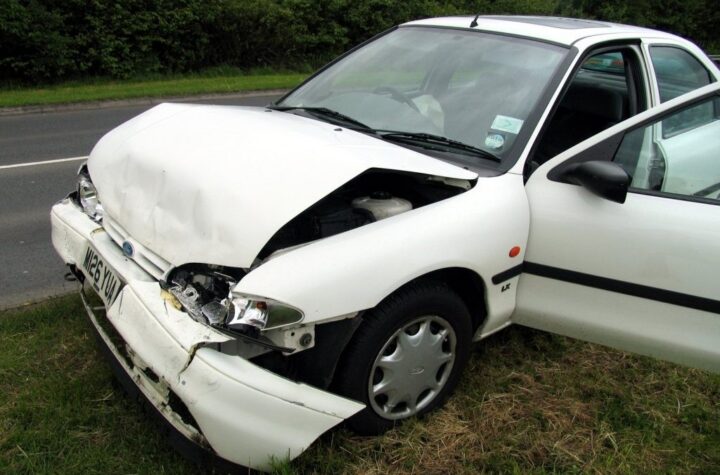
Toyota, Nissan and Honda all have made significant advances over the past 18 months. Most recently, Honda disclosed that it would introduce an ‘intellligent’ night vision system on the Legend this autumn. The system, which employs a pair of ‘far infrared’ cameras in the front bumper, provides the driver with both audio and visual warnings if a pedestrian comes into his path.
In ‘active’ safety, Toyota, with the launch of the remodeled Crown Majesta in July, has raised the bar for the industry. The luxury sedan, to be the flagship of the automaker’s revamped domestic model lineup with the arrival of Lexus next summer, is equipped with an all-new ‘vehicle dynamics integrated management system (called VDIM) which integrates steering, braking, vehicle stability and traction controls.
The system, developed for rear-wheel-drive cars, incorporates an array of sensors, actuators and controllers (see schematic) that keep the vehicle on a steady course even on icy road conditions. Researchers note that previous braking, steering, vehicle stability and traction control systems functioned independently whereas with VDIM each system is integrated and seamlessly managed.
Thus, on slippery surfaces the car takes over and automatically controls steering torque to prevent a spin-out. Similarly, if the driver oversteers while cornering, causing rear wheels to slip laterally, VDIM takes necessary corrective action.
Researchers note that integrated control of electronically brakes, engine and power steering begins before the car reaches its limits, thereby achieving a higher degree of preventive safety performance. The company estimates that braking performance has been improved by as much as 15 percent.
In developing the system, Toyota worked jointly with key suppliers including ADVICS Co. (a joint venture involving Aisin Seiki Co., Sumitomo Electric Industries, Ltd. and Denso Corp.), FAVESS Co. (a joint venture involving Koyo Seiko Co., Toyoda Machine Works, Ltd. and Denso), Denso, Matsushita Electric Industrial Co. and Tokai Rika Co.
ADVICS supplies the main braking system; FAVESS, the car’s electronic power steering system; Denso, the brake-system sensor; and Matsushita Electric and Tokai Rika, steering-torque and steering-angle sensors. The brake actuator was developed in-house by Toyota. Details of other components were not disclosed.
Hideo Inoue, a Toyota senior research executive, explains that the main difference between VDIM and the latest steering and braking systems developed for the Sport package of BMW’s 5-Series and 6-Series is that VDIM is an integrated system. “This is the first time for all systems to be integrated,” he says.
Besides the Crown Majesta, Toyota is expected to adopt the system on its new Lexus sedan and coupe lineup scheduled to hit dealer showrooms from 2005. These include the LS430, GS300 and GS430, IS300 and SC430. The company expects VDIM sales to reach 100,000 units per month around 2010.
[Toyota models with conventional ABS, vehicle stability and traction controls include the Alphard G, Alphard Hybrid, Alphard V, Aristo, Avensis, Avensis Wagon, bB, Brevis, Celsior (sold overseas as the LS430), Century, Crown Athlete, Crown Estate, Crown Royal, Estima Hybrid, Estima L, Estima T, Fun Cargo, Ipsum, ist, Kluger L, Kluger V, Mark II, Mark II Blit, Noah, Prius, Progres, RAV4-J, RAV4-L, Soarer, Voxy, Windom and Wish.]
Meanwhile, VDIM is the latest in a growing lineup of advanced safety features available on Toyota cars. In 2003 the automaker incorporated the world’s first radar-based precrash system into the Harrier, though not its overseas derivative, the RX330. However, the system is available on the LS430 as an option.
A brief review of safety technologies by Japan’s Big Three follows:
ANTI-LOCK BRAKES & BRAKE-ASSIST will be available on all models in all segments sold in Japan by 2008 including 660-cc minis, though not necessarily as standard equipment. Toyota, the market leader in this field, introduced ‘brake-assist on the Raum wagon in 1997. The system currently is available on nearly 50 models including sedans, minivans and SUVs, with both front- and rear-wheel drive and ranging from the 1.0L Vitz hatchback to the 3.0L Sienna van and 4.2-L Land Cruiser 100 SUV. By 2005, Toyota plans to offer the technology on almost all domestic models.
AUTOMATIC BRAKE ACTUATION is another strategic technology that will be gradually adopted on production models over the next 5-10 years. Both Honda and Nissan began marketing systems this year and plan to offer the technology as an option on all domestic models by 2010.
Meanwhile, Toyota introduced ‘pre-crash brake assist’ as an option on the Harrier, Celsior and Crown last year. Researchers explain that the system does not ‘activate’ the cars’ brakes. No timetable was given for wider application. Both the Estima Hybrid and Alphard Hybrid feature electronically controlled brake systems along with electronic brake-force distribution, brake-assist, vehicle stability control and traction control.
‘ACTIVE’ CRUISE CONTROL, like anti-lock brakes, brake-assist and automatic brake actuation, is another strategic technology Japanese carmakers feel will help prevent accidents. The timetable for introduction on most domestic cars is 2005 to 2010.
Toyota introduced adaptive cruise control with laser radar in 1997 on the Celsior and LS400 (predecessor of the LS430). The system (called ‘Radar Cruise Control) was subsequently adopted in Japan by the Progres, Crown ‘Majesta’, Crown ‘Royal’, Brevis, Estima, Estima Hybrid, Alphard and Alphard Hybrid and in the U.S. by the LS430, RX 330 and Sienna. No timetable was given for wider application.
Nissan plans to make adaptive cruise control optional on most models sold in Japan and the U.S. by 2005. For upper end models such as the Cima (Q45) or Skyline (G35), the system will be standard equipment. In Japan, the system is currently available on the Cima and President along with brake-assist with preview function.
Elsewhere, Honda introduced ‘Intelligent Highway Cruise Control’ on the Accord and Accord Wagon in October in 2002, Inspire in June 2003, and Odyssey in October 2003.
FRONT-COLLISION AVOIDANCE, while under development by all Japanese carmakers, is still only being marketed by Honda and Nissan which came out with optional systems in 2003. Toyota and others are expected to follow suit by 2005. Outside Japan, concerns about standards and product-liability issues outside Japan will limit availability until around 2010.
Nissan, with the minor change of the Cima last August, introduced a laser-radar sensor that measures the distance between the vehicle in front and sounds an alarm when there is danger of a rear-end collision. If the system computer determines a rear-end collision is unavoidable, it automatically applies the car’s brakes to reduce the severity of impact. The system subsequently was introduced on the remodeled President in September 2003.
Meanwhile, Honda introduced optional ‘collision mitigation brakes’ and E-pretensioner seatbelts with the launch of the remodeled Inspire in June 2003. The automaker subsequently equipped the new Odyssey with both systems in October. The Odyssey pricetag for a safety package that includes collision mitigation brakes, E-pretensioner seatbelts, intelligent highway cruise control and a multi-information display: $2,272.
Key system components include millimeter-wave radar; steering-angle, wheel-speed, brake-pressure and yaw-rate sensors; collision mitigation system ECU; variable-stability analyzer/integrated hydraulic brake unit; E-pretensioner; E-pretensioner ECU; and meter unit.
Researchers would like to introduce the system in the U.S. and European markets but is concerned about product liability issues. The automaker wants to introduce the system as an option on all models by 2008.
LANE-DEVIATION PREVENTION, which debuted in October 2002 on the Honda Accord (followed by the Honda Inspire in June 2003), is not ready for the U.S. because C-MOS cameras, mounted inside the front window, are designed to track painted road lines. The lines on many U.S. roads are warn, thus cannot be detected reliably.
Meanwhile, Nissan introduced a lane-deviation prevention system in 2001 on the Cima. Still available only on the Cima and President, the automaker plans to offer the technology (along with ‘intelligent braking’) on all upscale cars by 2010. Included will be the new Fuga, a near-production luxury concept car at the 2003 Tokyo Motor Show.
Senior researchers claim they still need to get a better understanding of “driver acceptance and passive value.” They believe the system has great potential in the U.S. where there is a growing senior population. Nissan’s basic philosophy regarding ASV technologies is to focus on systems that are relevant to customers. Management cited lane-keeping, adaptive-cruise control and active braking as three that are particularly relevant.
Elsewhere, Toyota has not yet introduced lane-deviation prevention although the automaker commercialized a lane-monitoring system on the Alphard passenger van in 2001. Mazda and Mitsubishi also have no models with the technology although Mitsubishi offered a lane-departure warning device several years ago on the Proudia and Dignity (both no longer in production) as well as the Diamante. The Diamante system was discontinued in an effort to bring down costs.
NIGHT VISION is one of the systems targeted by the Land, Infrastructure and Transport Ministry in the five-year third phase of the national project which runs from April 2001 to March 2006 (fiscal 2001 to fiscal 2005).
To date, Toyota has introduced a ‘near infrared’ system (called ‘Night View’) on the Lexus LX470 in the U.S. on the Crown Majesta and Land Cruiser ‘Sygnas’ (base model for the LX470) in Japan.
Elsewhere, although Honda plans to introduce a ‘far infrared’ system this autumn, researchers feel the technology is still too expensive. Nissan is also expected to offer the technology this autumn (Nissan is scheduled to launch six new models on Sept. 3).
‘ACTIVE’ HEAD RESTRAINTS are a priority for all Japanese carmakers. Nissan, which introduced the technology on the 2001 Cima and 2003 President, plans to make active head restraints available on all models by 2005.
Elsewhere, Mazda introduced ‘active’ head restraints as standard equipment on the RX-8, Axela and Atenza (Mazda 6). The technology is not yet available on other models including the MPV, Demio, Premacy, Tribute and Roadster, although analysts expect these to follow suit over the next 3-4 years.
Meanwhile, Toyota, which is expected to introduce the technology in the near future, notes that front-seat structures of most of its vehicles already incorporate ‘whiplash injury lessening’ technology. Honda and Mitsubishi, like Toyota, are developing the technology.












More Stories
Your Guide to Filing a Car Accident Claim
Steps to Take Immediately After a Car Accident
What Makes SUV Cars More Prone to Accidents?